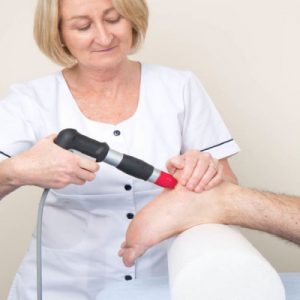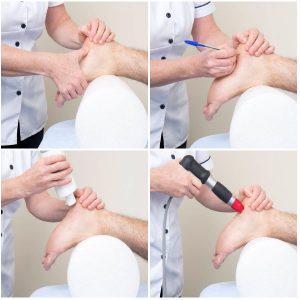Are you tired of living with pain that limits your daily activities and hampers your quality of life?
If so, it’s time to shatter the pain and embrace a groundbreaking solution: shockwave therapy.
This non-invasive and highly effective physiotherapy technique has been providing relief from musculoskeletal conditions and promoting
faster healing.
In this blog, we’ll delve into the world of shockwave therapy and explore how it can help you regain control of your body and live pain-free.

What is Shockwave Therapy?
Shockwave therapy, also known as Extracorporeal Shockwave Therapy (ESWT), is a cutting-edge treatment modality that uses high-energy sound waves to target specific areas of the body affected by pain or injury.
These sound waves are delivered through a handheld device, creating “shockwaves” that penetrate deep into the tissues, stimulating the body’s natural healing processes.

How Does Shockwave Therapy Work?
The shock waves generated during therapy trigger a cascade of beneficial effects within the body.
They promote increased blood circulation, the formation of new blood vessels, and the release of growth factors, which accelerate tissue repair and regeneration.
Additionally, shockwave therapy can break down scar tissue, reduce inflammation, and desensitise pain receptors, leading to significant pain relief and improved function.
Conditions Treated with Shockwave Therapy:
Shockwave therapy has shown remarkable success in treating a wide range of musculoskeletal conditions, including but not limited to:
● Plantar fasciitis
● Achilles tendinopathy
● Tennis elbow (lateral epicondylitis)
● Golfer’s elbow (medial epicondylitis)
● Patellar tendinopathy (jumper’s knee)
● Rotator cuff tendinopathy
● Hip bursitis
● Trigger points and muscle tightness
Advantages of Shockwave Therapy:
a) Non-invasive: Shockwave therapy is a non-surgical and non-injectable treatment option, making it an attractive alternative to more invasive procedures.
b) High success rate: Numerous studies have demonstrated the effectiveness of shockwave therapy, with many patients experiencing significant pain reduction and improved functionality after just a few sessions.
c) Minimal side effects: Compared to surgical interventions, shockwave therapy has minimal side effects, with most patients reporting only mild discomfort during the treatment itself.
d) Speedy recovery: Shockwave therapy accelerates the healing process, allowing patients to resume their daily activities and sports-related endeavours sooner.
What to Expect During a Shockwave Therapy Session:
During a shockwave therapy session, you can expect the following:
a) Evaluation: The physiotherapist will assess your condition and determine the appropriate treatment parameters.
b) Application: The therapist will apply gel to the treatment area to facilitate the transmission of shockwaves and then deliver the pulses using a handheld device.
c) Duration: Each session typically lasts between 10-20 minutes, depending on the condition being treated.
d) Number of sessions: The number of sessions required varies depending on the severity and chronicity of the condition. Most patients undergo 3-6 sessions, scheduled at weekly intervals.

Remember?
If you are interested in booking an appointment with one of our Chartered Physiotherapists or simply need some guidance, then please give us a call on 021-4633455 or book online below.
We hope you enjoyed this blog by Carol O’Brien, Chartered Physiotherapist
This blog is provided for information purposes only. The content is not intended to be a substitute for professional medical advice, diagnosis or treatment. Seek the advice of your doctor with any queries regarding a medical condition.
